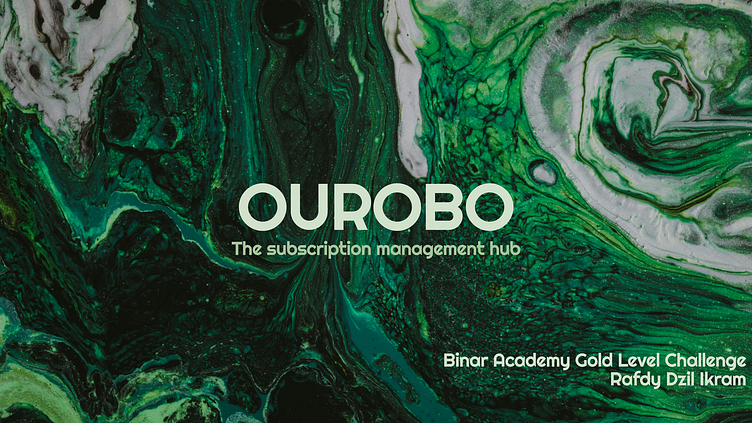Ourobo: The subscription management hub
Hi everyone, I'm Rafdy Dzil Ikram, a student at Binar Academy's UI/UX Design and Research Bootcamp, and this is my first product design project. I was tasked with designing an app that addresses a specific pain point. I chose to explore the hassle of managing multiple subscription services.
I picked this problem because, for several months, I've experienced the inconvenience of receiving notifications from Apple about purchases or auto-renewals only at the end of the month. Without real-time receipts or renewal reminders, I often ended up overspending my monthly budget.
To start, I conducted some secondary research and found the following:
93% of users across Asia want a single hub to manage all their subscriptions due to the sheer number of subscriptions they have. Many users reported losing track of their subscriptions; 44% said they were paying for services they had forgotten about, and 32% said they were paying for services they no longer used (Bango, 2023).
Cancelling a subscription service is often intentionally difficult. Users described the process as absurd, convoluted, and time-consuming. These "dark" patterns are designed for the companies' benefit rather than the consumers' needs (Tomaschek, 2022)
Clearly, there is a problem with users losing track of their subscription services. They struggle with tracking their expenses and identifying services they no longer need.
The following section outlines the research objectives of this project based on my secondary research and problem statement:
The hypotheses for this research are as the following:
H1: Users are subscribed to multiple services, some of which are well-tracked while others are not, depending on their importance.
H2: Users use a single payment gateway for most services, though they may use a different one if required by the service.
H3: Users have encountered difficulty in keeping track of their ongoing subscriptions at least once.
H4: Users want to be informed and reminded of their spending on such services.
Over the next two weeks, I contacted around six subjects; unfortunately, only three were able to participate. The subjects I targeted met the following criteria:
Aged 25-35
Tech-savvy
Responsible for their own purchases
Subscribed to at least one service
Have renewed a subscription service before
Each subject was interviewed for 30-45 minutes using open-ended questions designed to satisfy the research objectives. I then collected and summarized their input into the following information:
After establishing the foundations, I moved on to crafting the user flow. I envisioned an app where users can track all their subscriptions in one place. They can:
See subscription services available in their region, including prices and benefits.
Connect their preferred payment gateway to the app if possible; otherwise, registering them would suffice.
Set their own monthly budget.
View promotions for various services or updates on new features and content.
From this vision, I created the basic user flow for the app, which I named Ourobo. The name is derived from "ouroboros," the emblem of wholeness, symbolizing the balanced expenditure we aim to achieve in today's saturated market of entertainment services.
Next, I set up a simple color and font library to define the design language for the app. I chose shades of natural green to evoke a sense of calmness. For the font, I selected Urbanist to introduce a modern feel.
From there, I went to the design for three main user flow:
Login and budget set up
Add payment method
Add subscription service and reminder
Here's a closer look at the homepage, payment method page, and subscription service page in their completed/filled out states
You can find the full user flow prototype here.
I aimed to make the design clean and intuitive while incorporating some slightly complex UX flows for tech-savvy users. The goal is to present all necessary information about the user's subscriptions as clearly as possible.













